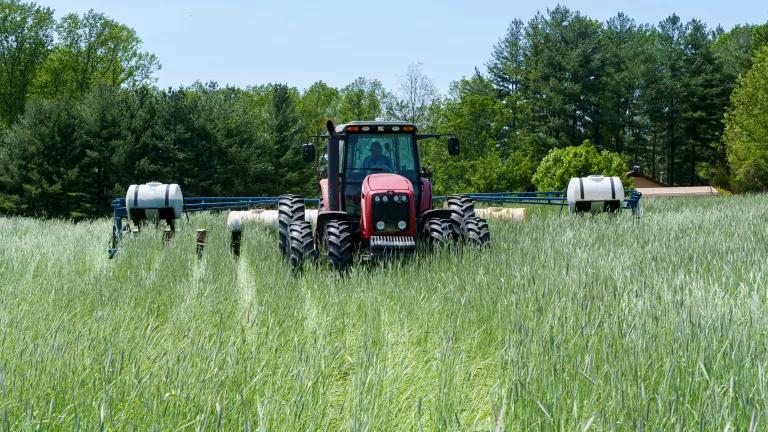A new report released by Duke University's Nicholas Institute for Environmental Policy Solutions adds to a growing body of analysis, including a recent study by USDA, which shows how U.S. farmers are well-positioned to gain from clean energy and climate legislation, such as the House-passed American Clean Energy and Security Act (ACES).
As I've discussed in previous blogs, studies that purport to evaluate the impacts of ACES on the agricultural sector but focus only on increases to the costs of fossil inputs tell only half the story and are thus highly misleading. No such analysis is complete without consideration of both the costs and benefits to farmers. The independent Nicholas Institute report does just that, focusing on four key clean energy and climate policy drivers that affect the agricultural sector:
- 1) The ACES cap on greenhouse gas (GHG) emissions that will gradually increase the costs of fossil-fueled energy and energy-intensive products vs. clean, renewable energy;
- 2) The ACES offsets program in which capped firms can meet their compliance obligations by purchasing carbon offsets from uncapped sectors such as agriculture and forestry;
- 3) The Energy Independence and Security Act of 2007, which boosted the required volume of biofuels under the Renewable Fuels Standard (RFS), established mandates for the use of second generation cellulosic biofuels and added GHG emission reduction thresholds for several classes of biofuels; and
- 4) The ACES Renewable Electricity Standard (RES), which mandates a certain share of U.S. annual electricity come from renewable sources, such as bioenergy, wind and solar.
Using a recently updated and enhanced Forest and Agricultural Sector Optimization Model with Greenhouse Gases (FASOMGHG), the team modeled the effects of these policies on the U.S. agricultural sector. The model was used to simulate agricultural and forestry production responses to changes in carbon prices at a price of $15, $30 and $50 per ton of carbon dioxide equivalent (tCO2e), including how production practices, land use, and different markets respond, and the resulting GHG flows in the sector.
Under a cap and trade system in which agriculture and forestry remain uncapped but participate in the carbon market by selling offsets, the results show that both sectors have the potential to generate significant supplies of offsets-and thus new sources of revenue-from activities that reduce direct on-farm emissions and enhance carbon sequestration in soils and forests. In addition, the study finds that increased emphasis on second generation cellulosic biofuels creates new markets for agricultural residues like corn stover and wheat straw and dedicated energy crops like switchgrass. In addition to these direct benefits in the form of lucrative alternatives for managing farmland, renewable energy mandates also provide indirect benefits through increased prices for conventional agricultural commodities as land is allocated to energy production.
The results show that though the costs of GHG-intensive, fossil fuel farm inputs increase, the total cost burden changes little across carbon price scenarios, primarily because farmers are assumed to adapt in response to higher input prices and GHG-offsetting alternatives to traditional crop management. This is an important enhancement to the USDA analysis which, as I discussed here, produced what is likely a conservative estimate of net benefits to farmers from ACES because it assumed no change in technology or on-farm production practices in response to changing market conditions.
Though indirect benefits are the largest component of additional revenue, the Nicholas Institute estimates that new direct revenues to farmers for emissions reductions and sequestration, both as a result of offset activities and abatement resulting from greater bioenergy production, will be in the range of $1.77-$18.11 billion per year.
For comparison, EPA estimates that in 2020, at a carbon price of $30/tCO2e, 404 million metric tons of domestic agricultural and forestry offsets could be available, worth over $12 billion to the agriculture and forestry sectors. In addition, a 2005 USDA study estimated that U.S. farmers could sustainably harvest 75 million dry tons of corn stover. Sold as feedstock for bioenergy production at a market price of $50 per dry ton, this translates to roughly $2.85 billion in annual net profits from stover alone. Together, this means nearly $15 billion in new revenues.
Despite increases in the costs of fossil fuel inputs, farmers are well-positioned to benefit from clean energy and climate legislation, both directly from new and expanded markets for bioenergy and offsets-based emissions reduction, and indirectly from increases in commodity and land prices. Importantly, the Nicholas Institute analysis does not take into account other important revenue opportunities for farmers from expanded renewables markets, such as lucrative land leases for wind power, whose deployment will be bolstered by the ACES cap on GHG emissions and complementary policies like the RES.



